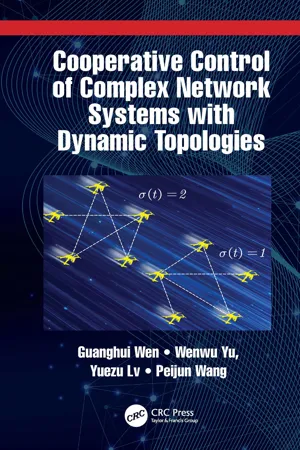
Cooperative Control of Complex Network Systems with Dynamic Topologies
- 304 pages
- English
- ePUB (mobile friendly)
- Available on iOS & Android
Cooperative Control of Complex Network Systems with Dynamic Topologies
About this book
Far from being separate entities, many social and engineering systems can be considered as complex network systems (CNSs) associated with closely linked interactions with neighbouring entities such as the Internet and power grids. Roughly speaking, a CNS refers to a networking system consisting of lots of interactional individuals, exhibiting fascinating collective behaviour that cannot always be anticipated from the inherent properties of the individuals themselves.
As one of the most fundamental examples of cooperative behaviour, consensus within CNSs (or the synchronization of complex networks) has gained considerable attention from various fields of research, including systems science, control theory and electrical engineering. This book mainly studies consensus of CNSs with dynamics topologies - unlike most existing books that have focused on consensus control and analysis for CNSs under a fixed topology. As most practical networks have limited communication ability, switching graphs can be used to characterize real-world communication topologies, leading to a wider range of practical applications.
This book provides some novel multiple Lyapunov functions (MLFs), good candidates for analysing the consensus of CNSs with directed switching topologies, while each chapter provides detailed theoretical analyses according to the stability theory of switched systems. Moreover, numerical simulations are provided to validate the theoretical results. Both professional researchers and laypeople will benefit from this book.
Frequently asked questions
- Essential is ideal for learners and professionals who enjoy exploring a wide range of subjects. Access the Essential Library with 800,000+ trusted titles and best-sellers across business, personal growth, and the humanities. Includes unlimited reading time and Standard Read Aloud voice.
- Complete: Perfect for advanced learners and researchers needing full, unrestricted access. Unlock 1.4M+ books across hundreds of subjects, including academic and specialized titles. The Complete Plan also includes advanced features like Premium Read Aloud and Research Assistant.
Please note we cannot support devices running on iOS 13 and Android 7 or earlier. Learn more about using the app.
Information
CHAPTER 1
Introduction
1.1 Complex network systems
1.2 Definitions of synchronization and consensus
- A complex network typically contains a great number of individual nodes (e.g., the Internet) while the scale of an MAS may be relatively quite small (e.g., a team of several robots).
- The objective of synchronization control is to make the states of a large-scale network achieve state agreement under some given inner linking matrices by selecting only the coupling strength, while the objective of consensus is to make the states of agents achieve state agreement by designing the gain matrices as well as the coupling strength.
- Significant attention has been paid to revealing the relationship between the statistical properties (e.g., the degree distribution, the average path length, and the symmetry) of network topology and the synchronizability of complex networks within the context of synchronization in complex networks, while in the context of consensus of MASs, much attention has been focused on addressing the relationship between the algebraic properties (e.g., the algebraic connectivity for undirected interaction topology and the general algebraic connectivity for directed interaction topology) of interaction topology and the consensusability.
Table of contents
- Cover
- Half Title
- Title Page
- Copyright Page
- Contents
- Preface
- CHAPTER 1 ▪ Introduction
- CHAPTER 2 ▪ Preliminaries
- CHAPTER 3 ▪ Consensus of linear CNSs with directed switching topologies
- CHAPTER 4 ▪ Consensus disturbance rejection of MIMO linear CNSs with directed switching topologies
- CHAPTER 5 ▪ Consensus tracking of CNSs with first-order nonlinear dynamics and directed switching topologies
- CHAPTER 6 ▪ Consensus tracking of CNSs with higher-order dynamics and directed switching topologies
- CHAPTER 7 ▪ H-infinity consensus of CNSs with directed switching topologies
- CHAPTER 8 ▪ Distributed tracking of nonlinear CNSs with directed switching topologies: An observer-based protocol
- CHAPTER 9 ▪ Cooperative tracking of CNSs with a high-dimensional leader and directed switching topologies
- CHAPTER 10 ▪ Neuro-adaptive consensus of CNSs with uncertain dynamics
- CHAPTER 11 ▪ Resilient consensus of CNSs with input saturation and malicious attack under switching topologies
- Bibliography
- Index